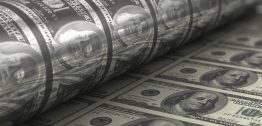You have permission to back up the truck and buy with both hands – for now.
That’s because the International Monetary Fund’s latest Global Financial Stability report has given traders the “All Clear!” signal.
At least until 2020.
You see, that’s the year a debt crisis hits the global economy, at least in an IMF simulation. In the game theory exercise, the crisis sends tremors through the financial system and asset markets.
The simulation is probably more of an exercise in risk prevention than it is a forecast. Still, the lessons of the crisis simulation are worth heeding.
Just not yet.
That’s because everyone seems to have capitulated to this market: “The market IS going higher.” And understandably so.
The bull is raging at a time when simultaneous global growth seems to be unveiling a sustainable, expansionary environment.
Overall, I tend to agree.
But I can’t ignore the biggest risks or the looming potential for a significant correction .
For now, consider U.S. corporate debt …
An author at CNN Money just announced that America was “great again” before Donald Trump was elected president. He declared American corporations were already “great again.” He added: “The bad results are the exceptions, not the rule.”
It’s hard to argue otherwise. Earnings growth has been solid since last year despite how many times I’ve pointed to corporate debt levels that are frothy, to say the least.
Well, to that point, I came across an intriguing chart this week: U.S. corporate debt as a ratio of cash flows.

Conceivably, debt is not a problem if it can be financed.
That’s why my concern, and the concern of The Edelson Institute, has always been on what might happen to alter the capacity of a company, municipality or country to service its debt.
An expansionary environment bodes well for financing.
That is unless corporations are short on cash when financing costs – interest rates – rise. Or when liquidity dries up.
And – almost as though I planned it this way – on a historical basis, corporations today are short on cash relative to debt.
An era of low interest rates has made that trend sustainable. The compression of credit spreads is indicative of the impact low interest rates are having on the riskiness of companies.
And that’s a risk, since the market is not pricing credit appropriately relative to corporate debt/cash ratio.
We may not get a recession, but we don’t need one for those credit spreads to widen.
All that needs to happen is for the markets to react adversely to volatility, rising interest rates or their own shadows, for that matter. That’s because selling can beget more selling, and so on and so forth.
If liquidity recedes and credit spreads widen, suddenly Corporate America doesn’t look so great again.
The bulls are running. Beware a snapback to put irrational exuberance back in its place.
Do right,
JR Crooks
P.S. Our research team recently revealed two newly discovered cycles that are on a collision course with this coming Tuesday, Oct. 31. A collision that virtually guarantees that the years 2017 through 2022 will be the most chaotic of our lifetimes. This crisis has four phases … and four great fortunes you can amass as it unfolds. And you only have four days left to see how it can turn every $10,000 you invest into more than $136,000! Don’t wait — click here now before it’s too late.



penny cornelius November 1, 2017
where should one buy silver and should it be physical coins? or ??
Antoaneta Pinto October 30, 2017
Are you kidding us all? On the same page you recommend to back up the truck and you predict a mayhem tomorrow. So which one is valid?
John October 27, 2017
Yes, it is a matter of time ( a few months) before the ‘Great Tsunami’ kicks in.
Look down,please !!
Mike Kramer October 27, 2017
I just wish that I knew who was right. For almost three years I have read about previous predictions being correct, the dollar dying, we are going to have a depression that would make 1929 look like a Sunday picnic. These were made by a list of analysts, hedge fund managers, former cabinet members under prior presidents etc. No doubt they could all make the economists hall of fame. The problem is that not one of them has had a current prediction come true. If I had any money to invest, I would not because of all the confusion. They all have a survival plan that anyone can get. Just buy their book, get their newsletter etc. Hate to burst your bubble as I wait for one the many said to exists does.
Tom M October 27, 2017
If you trust the IMF or CNN for anything, I think you might as well go to the casino or the track and bet. For sure, we will have another monster sell off in the markets…sometime between now and 2032.
john October 27, 2017
Back up the truck for WHAT? You don’t even say. Gold, stock market, coffee , tea or orange juice?
RICK October 27, 2017
WHY NOT INVESTED FULLY IF ALL THIS MONEY WILL FLOOD IN TO THE MKT?